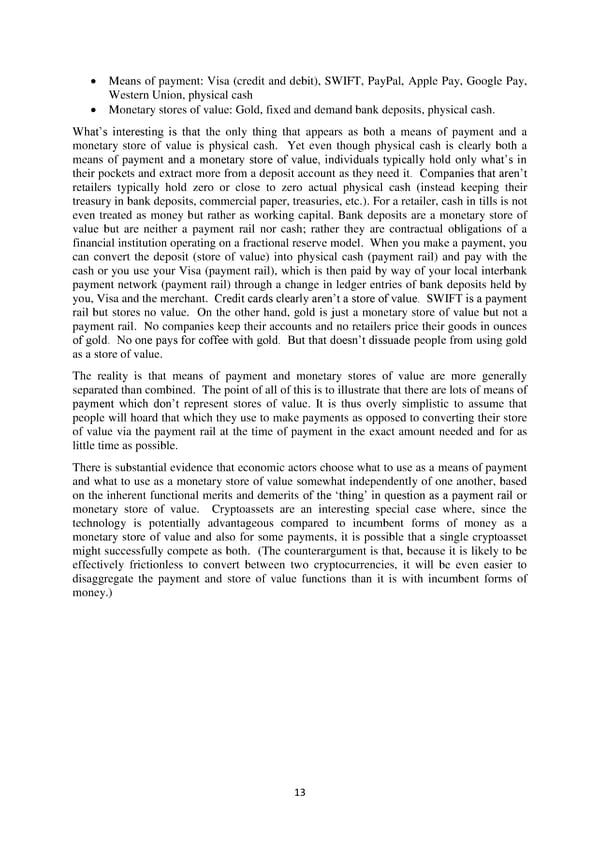• Means of payment: Visa (credit and debit), SWIFT, PayPal, Apple Pay, Google Pay, Western Union, physical cash • Monetary stores of value: Gold, fixed and demand bank deposits, physical cash. What’s interesting is that the only thing that appears as both a means of payment and a monetary store of value is physical cash. Yet even though physical cash is clearly both a means of payment and a monetary store of value, individuals typically hold only what’s in their pockets and extract more from a deposit account as they need it. Companies that aren’t retailers typically hold zero or close to zero actual physical cash (instead keeping their treasury in bank deposits, commercial paper, treasuries, etc.). For a retailer, cash in tills is not even treated as money but rather as working capital. Bank deposits are a monetary store of value but are neither a payment rail nor cash; rather they are contractual obligations of a financial institution operating on a fractional reserve model. When you make a payment, you can convert the deposit (store of value) into physical cash (payment rail) and pay with the cash or you use your Visa (payment rail), which is then paid by way of your local interbank payment network (payment rail) through a change in ledger entries of bank deposits held by you, Visa and the merchant. Credit cards clearly aren’t a store of value. SWIFT is a payment rail but stores no value. On the other hand, gold is just a monetary store of value but not a payment rail. No companies keep their accounts and no retailers price their goods in ounces of gold. No one pays for coffee with gold. But that doesn’t dissuade people from using gold as a store of value. The reality is that means of payment and monetary stores of value are more generally separated than combined. The point of all of this is to illustrate that there are lots of means of payment which don’t represent stores of value. It is thus overly simplistic to assume that people will hoard that which they use to make payments as opposed to converting their store of value via the payment rail at the time of payment in the exact amount needed and for as little time as possible. There is substantial evidence that economic actors choose what to use as a means of payment and what to use as a monetary store of value somewhat independently of one another, based on the inherent functional merits and demerits of the ‘thing’ in question as a payment rail or monetary store of value. Cryptoassets are an interesting special case where, since the technology is potentially advantageous compared to incumbent forms of money as a monetary store of value and also for some payments, it is possible that a single cryptoasset might successfully compete as both. (The counterargument is that, because it is likely to be effectively frictionless to convert between two cryptocurrencies, it will be even easier to disaggregate the payment and store of value functions than it is with incumbent forms of money.) 13
 Investor’s Take on Cryptoassets by John Pfeffer Page 12 Page 14
Investor’s Take on Cryptoassets by John Pfeffer Page 12 Page 14